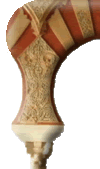

Cheng Muhammad Ho: ( Zheng He or Zheng hay) birth.CE. 1371 Demise.CE. 1435). The voyages of Cheng Ho admiral and diplomat who helped to extend the Chinese maritime and commercial influence throughout the regions bordering the Indian Ocean.
...Zheng He (who was a Muslim), his voyages were the earliest extensive naval expeditions in world History. He took 63 ‘starry rafts’ up to 1500 tons 162 X 66 m long with four decks and 255 smaller ships accompanying 28,000 men and took them to Mecca...
(The Cambridge, Biographical Encyclopedia, By David Crystal 1998 PG.1022)
...In the Indian Ocean the Portuguese had made contact with Chinese navigators who had rounded the Cape of Good Hope in early 15th century. The Chinese ships were four or five times longer then Columbus’s vessels; huge ships using the technology later used by the west to dominate the globe: gunpowder, stern rudders, watertight compartments, compasses. Their sailing gazetteers mapped the staging posts China to Madagascar; their fleets carried up to 27,000 men with shipboard gardens growing fresh vegetables. In the 1420s a Chines junk had sailed forty days into South Atlantic; and Chinese sailors walked the streets of Jeddah on the Red Sea...
(Conquistadors, By Michael Wood, 2001, PG.20)
Click on play to see Cheng Muhammad Ho’s Voyages
Cheng Muhammad Ho was the son of a hajji, a Muslim who had made the pilgrimage to Mecca. His family claimed descent from an early Mongol governor of Yunnan and a descendant of King Muhammad of Bukhara. The family name Ma was derived from the Chinese rendition of Muhammad. In 1381, when he was about 10 years old, Yunnan, the last Mongol hold in China, was reconquered by Chinese forces led by generals of the newly established Ming dynasty. The young Muhammad Ho, as he was then known, was among the boys who were captured, castrated, and sent into the army as orderlies. By 1390, when these troops were placed under the command of the Prince of Yen, Muhammad Ho had distinguished himself as a junior officer, skilled in war and diplomacy; he also made influential friends at court.
In 1400 the Prince of Yen revolted against his nephew, the Chien-wen emperor, taking the throne in 1402. Under the Yung-lo administration (1402-24), the war-devastated economy of China was soon restored. The Ming court then sought to display its naval power to bring the maritime states of South and Southeast Asia in line.
For 300 years the Chinese had been extending their power out to sea. An extensive seaborne commerce developed to meet the taste of the Chinese for spices and aromatics and the need for raw industrial materials. Chinese travellers abroad, as well as Indian and Muslim visitors, widened the geographic horizon of the Chinese. Technological developments in shipbuilding and in the arts of seafaring reached new heights by the beginning of the Ming.
The Emperor having conferred on Muhammad Ho, who had become a court eunuch of great influence, the surname Cheng, he was henceforth known as Cheng Ho. Selected by the Emperor to be commander in chief of the missions to the "Western Oceans," he first set sail in 1405, commanding 62 ships and 27,800 men. The fleet visited Champa (now South Vietnam), Siam, Malacca, and Java; then through the Indian Ocean to Calicut, Cochin, and Ceylon (now Sri Lanka). Cheng Muhammad Ho returned to China in 1407.
On his second voyage, in 1409, Cheng Muhammad Ho encountered treachery from King Alagonakkara of Ceylon. He defeated his forces and took the King back to Nanking as a captive. In 1411 Cheng Muhammad Ho set out on his third voyage. This time, going beyond the seaports of India, he sailed to Hormuz on the Persian Gulf. On his return he touched at Samudra, on the northern tip of Sumatra.
On his fourth voyage Cheng Muhammad Ho left China in 1413. After stopping at the principal ports of Asia, he proceeded westward from India to Hormuz. A detachment of the fleet cruised southward down the Arabian coast, visiting Djofar and Aden. A Chinese mission visited Mecca during the Hajj season and continued to Egypt. The fleet visited Brava and Malindi and almost reached the Mozambique Channel. On his return to China in 1415, Cheng Ho brought the envoys of more than 30 states of South and Southeast Asia to pay homage to the Chinese emperor.
During Cheng Muhammad Ho's fifth voyage (1417-19), the Ming fleet revisited the Persian Gulf and the east coast of Africa. A sixth voyage was launched in 1421 to take home the foreign emissaries from China. Again he visited Southeast Asia, India, Arabia, and Africa. In 1424 the Yung-lo emperor died. In the shift of policy his successor, the Hung-hsi emperor, suspended naval expeditions abroad. Cheng Muhammad Ho was appointed garrison commander in Nanking, with the task of disbanding his troops.
Cheng Muhammad Ho's seventh voyage left China in the winter of 1431, visiting the states of Southeast Asia, the coast of India, the Persian Gulf, the Red Sea, and the east coast of Africa. He returned to China in the summer of 1433 and died in 1435.
Cheng Muhammad Ho was the best known of the Yung-lo emperor's diplomatic agents. Although some historians see no achievement in the naval expeditions other than flattering the emperor's vanity, these missions did have the effect of extending China's political sway over maritime Asia for half a century. Admittedly, they did not, like similar voyages of European merchant-adventurers, lead to the establishment of trading empires. Yet, in their wake, Chinese emigration increased, resulting in Chinese colonization in Southeast Asia and the accompanying tributary trade, which lasted to the 19th century.
(Encyclopedia Britannica, 2001)